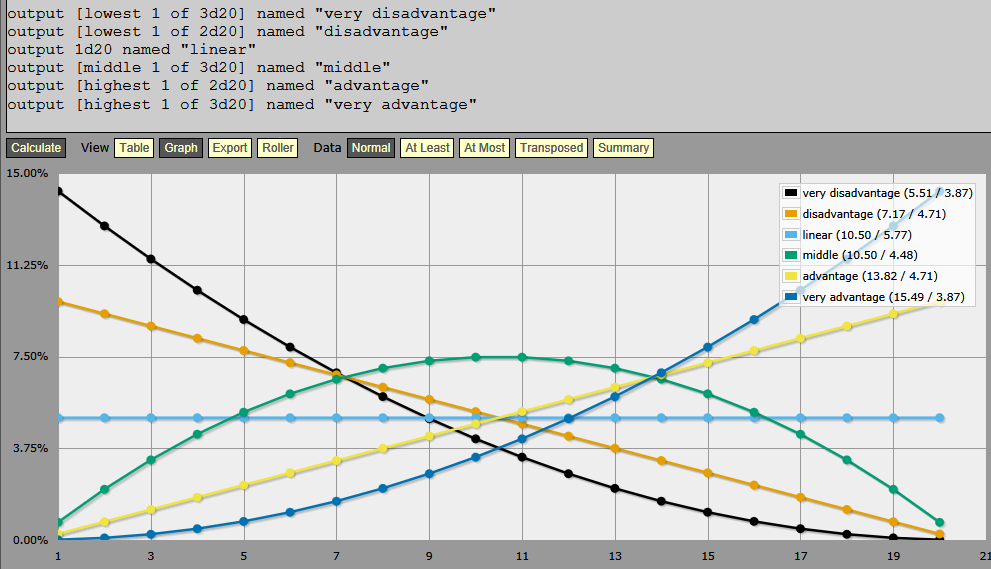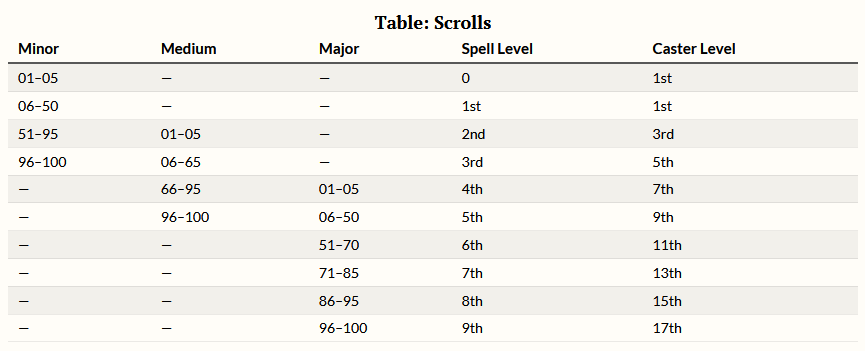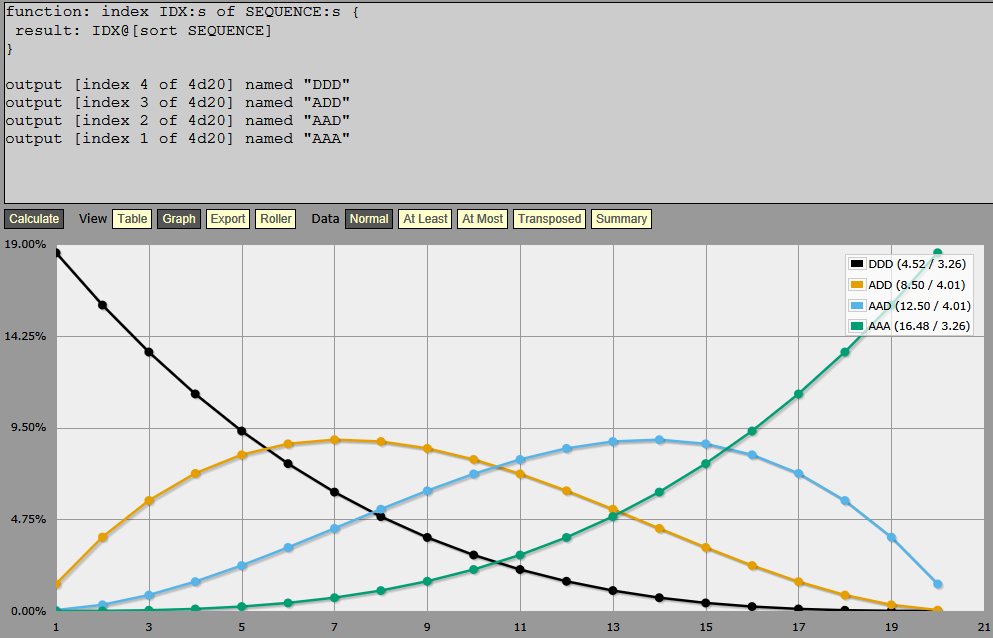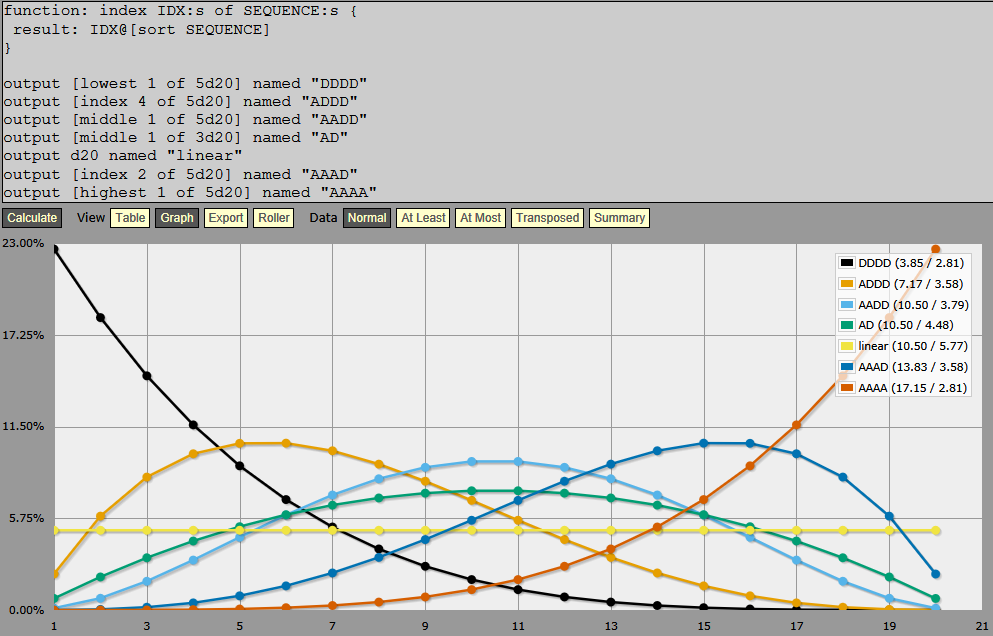In expanding on the adventure nodes in yesterday’s post, I stumbled on an idea I’d like to explore.
This isn’t truly part of building the adventure, but it was sparked by an observation I had while doing so, so I’m considering it fair game for inclusion.
For now, I’ll refer to this idea as a ‘polarized table’. It can be used to generate results in a linear manner, or weighted toward one end or the other.
In an encounter table, you might have three zones: ‘easy’, ‘medium’, and ‘hard’. You create an encounter table with the weakest creatures in the lower-number slots, strongest in the higher-number slots, and the ‘average’ in the ‘middle’ slots. When it comes time to use it, you’ve got a few choices.
One of the simplest is to use different rolls on the tables. If you’re rolling for an encounter in the ‘easy’ area, you roll d12. In the ‘hard’ area, you roll d12+8. In the ‘medium’ area you might roll d10+5 (so you get mostly medium encounters, with a few of the ‘hardest of the easiest’ and the ‘easiest of the hardest’).
Slightly more work, you assign three different columns of ‘target numbers’, one for easy, medium, and hard. Or, as shown in the table below, ‘low-level spells’, ‘medium-level spells’, and ‘high-level spells’.
In both cases, you segregate the results by group (minor, medium, major, in this case). Each group is focused, but excludes a large amount of the table.
‘Polarized tables’ let you have potential access to the entire range of results, while keeping the focus on the region of interest. That is, with an encounter table you will much more likely encounter an ogre in the ‘easy area’ rather than a dragon, and vice-versa in the ‘hard area’.
It’s pretty simple: leverage the ‘advantage’ and ‘disadvantage’ mechanism. When rolling for an ‘easy encounter’, roll 2d20 and take the lower value. If you want a ‘hard encounter’, roll 2d20 and take the higher value. If you’re rolling for a ‘medium encounter’, either roll d20, or roll 3d20 and take the middle value (depending on whether you want ‘medium encounter’ to represent something from the middle rather than something from anywhere). You can scale it even further by rolling 3d20 and taking the lowest or highest as appropriate.
The table below shows the percentage chance of any particular result, when rolling ‘Very Disadvantaged’, ‘Disadvantaged’, ‘Linear’, ‘Middle’, ‘Advantaged’, and ‘Very Advantaged’
| Result | V. Disad | Disad | Linear | Middle | Adv | V. Adv |
| min(3d20) | min(2d20) | 1d20 | middle(3d20) | max(2d20) | max(3d20) | |
| 1 | 14.26 | 9.75 | 5 | 0.72 | 0.25 | 0.01 |
| 2 | 12.84 | 9.25 | 5 | 2.08 | 0.75 | 0.09 |
| 3 | 11.49 | 8.75 | 5 | 3.27 | 1.25 | 0.24 |
| 4 | 10.21 | 8.25 | 5 | 4.33 | 1.75 | 0.46 |
| 5 | 9.01 | 7.75 | 5 | 5.22 | 2.25 | 0.76 |
| 6 | 7.89 | 7.25 | 5 | 5.97 | 2.75 | 1.14 |
| 7 | 6.84 | 6.75 | 5 | 6.58 | 3.25 | 1.59 |
| 8 | 5.86 | 6.25 | 5 | 7.03 | 3.75 | 2.11 |
| 9 | 4.96 | 5.75 | 5 | 7.33 | 4.25 | 2.71 |
| 10 | 4.14 | 5.25 | 5 | 7.47 | 4.75 | 3.39 |
| 11 | 3.39 | 4.75 | 5 | 7.47 | 5.25 | 4.14 |
| 12 | 2.71 | 4.25 | 5 | 7.33 | 5.75 | 4.96 |
| 13 | 2.11 | 3.75 | 5 | 7.03 | 6.25 | 5.86 |
| 14 | 1.59 | 3.25 | 5 | 6.58 | 6.75 | 6.84 |
| 15 | 1.14 | 2.75 | 5 | 5.97 | 7.25 | 7.89 |
| 16 | 0.76 | 2.25 | 5 | 5.22 | 7.75 | 9.01 |
| 17 | 0.46 | 1.75 | 5 | 4.33 | 8.25 | 10.21 |
| 18 | 0.24 | 1.25 | 5 | 3.27 | 8.75 | 11.49 |
| 19 | 0.09 | 0.75 | 5 | 2.08 | 9.25 | 12.84 |
| 20 | 0.01 | 0.25 | 5 | 0.72 | 9.75 | 14.26 |
If you’re rolling for an encounter in the ‘easy area’, you’d roll ‘Disadvantaged’ or ‘Very Disadvantaged’: 2d20 or 3d20, taking the lowest. If rolling ‘Disad’ there is a 75% chance of ending up in the lower half of the table, if rolling ‘V. Disad’ there is an 87.5% chance of being in the lower half of the table. In both cases, though there is the possibility of getting a higher result. The highest result might be vanishingly infrequent — 1/8000 if rolling ‘very disadvantaged’ — but it’s not totally impossible, and while 0.25% is pretty unlikely it’s not totally unheard of.
I mean, we all managed roll at least one first-edition fighter with 18/00 Strength, right? 3d6 in order, swear to god.
The same pattern, simply reversed, happens at the upper end if you roll ‘Advantaged’ or ‘Very Advantaged’.
The linear result is self-explanatory, but I find the ‘middle’ result interesting.
| Range | Frequency |
| 10-11 | 14.94% |
| 9-12 | 29.60% |
| 8-13 | 43.66% |
| 7-14 | 56.82% |
| 6-15 | 68.76% |
The remainder is divided evenly between lower and higher results. The middle six in the center — 8-13 differ by less than half a percent from least common to most common (7.03% to 7.47%). That’s as close to flat as I could care to ask, and the fourth entry (6 or 14) is still within 1% of the highest (6.58%).
Pictorially…

I used random encounters in this post as a simple case that required little additional context, but there are other uses. Just about any time you might want three different zones in the same table, you could reasonably use polarized tables.
- Magic item selection (as shown above with minor/medium/major scrolls);
- Character traits, especially those already polarized (a lawful character might ‘roll disadvantage’ a table that could have ‘honest’ in a low-numbered slot and ‘deceptive’ in a high-numbered slot — it’s not impossible that a lawful character is deceptive, but many expect lawful characters are more likely to be honest).
- This could be inverted: a character with the ‘honest’ trait might roll with disadvantage to see if he’s lawful or chaotic. He’s more likely to be lawful than chaotic, but you can’t rule it out.
- It can even be extended: a character with no lawful or chaotic traits might roll 1d20, a character with one lawful and one chaotic trait might roll 3d20 and take the middle one, and one with two lawful traits and one chaotic trait might roll 4d20 and take the second lowest (discarding the two highest and the one lowest). I haven’t actually run numbers on that last option, though.
- Planar or energy traits: a plane of fire might roll on a fire-normal-water polarized table to see what it’s like. It’s not impossible for there to be a water-based trait there (though it’s unlikely… and probably short-lived or turns to steam), but it’s much more likely to be fire-based.
- Settlement traits: a lawful settlement could have some degree of corruption (possibly formalized, even), but you’re more likely to see corruption in a chaotic settlement (even if it has lots of rules).
I can see many places this might be useful. I’ll have to explore them.
Brief Addendum
I poked around a bit more with AnyDice and generated several more options, using increasing numbers of dice. I’m not entirely convinced it’s worth the extra trouble at the table, but it was worth the extra trouble to think about.
First, using 4d2: DDD (d20 with three disadvantage dice), ADD (d20 with one advantage die and two disadvantage dice), AAD, AAA.
This gives me a few focal points (of sorts) but I lose the middle one. Obviously five dice will fix that, but what does it look like?
Busy, busy, busy diagram (seven lines!), but manageable because of the symmetry.
I think mathematically this has the characteristics I’m looking for. I have three focal points (about 5.5, 10.5, 15.5) that are fairly flat near the focal point then drop pretty quickly to either side. I can still have outliers at either end, but even when I’m ‘in that region’ the odds of rolling the outlier (the weakest or strongest) is relatively small. Still several times higher than with some of the other rolls, but small enough that I can afford to put something that is more extreme than might otherwise be acceptable.
That is, I can probably afford to have ogres and dragons on the same table. The chance of getting one in the right region is small, the chance of getting one in the next region is even smaller, and the chance of getting one in the wrong region is vanishingly small. The most extreme formula (all disadvantage or all advantage) doesn’t do that, even when there are only two dice, let alone five (at which point you have a 23% of getting the lowest or highest value, depending which formula).
I’m just not sure I want to roll 5d20 when… actually, aw hell, 5d20 and select isn’t so much, I guess. Not when it gives me the opportunity to get results like this.




Good stuff, Keith! Been enjoying this series quite a bit. This one struck a particular chord with me. For years I’ve periodically pondered how to make use of probability density functions in game mechanics and specifically for things like the DragonQuest skill rolls. The functions are, of course, too complicated to use on the fly at the gaming table. It is pretty straightforward to create a table that would cross-reference a character’s skill at something versus the difficulty of the task and give their percentage chance to succeed. However, it gets more complicated if a third variable (such as Manual Dexterity) is involved. The use of multiple D20s and keeping the high/middle/low die is an interesting mechanic and is easily used.
What program did you use for your calculations and graphs?
DragonQuest, wow… there’s a blast from the past. I remember being really impressed that everything had a unique ID attached (a spell didn’t just have a name, it was ‘Q1. Spell name’).
I’m glad you’re enjoying this series. It looks like it will actually have a couple of purposes: first as a sample adventure for Echelon, and I’m likely to use it as an example in a book I’m writing of how to create adventures and campaigns using these techniques.
The dice calculations and graphs were done using AnyDice (http://www.anydice.com/). It’s a very useful tool.
The calculations shown here can be found at http://anydice.com/program/f786.
Looking forward to seeing where this all leads. Thanks for the link to AnyDice. I’ll be able to waste even more time now! :)
You’re welcome. I’m looking forward to seeing where this all leads too. I don’t know yet myself!
Hello, fellow A-to-Zer! I have never made an RPG myself, but I am interested in game mechanics, so this was a pretty solid read. And I love the graphs! Very clearly presented.
Sorry to reach out to you in an older post but could you clarify something to me? You mention DDA, AAD, AADD, etc. What was your method for combining both advantage and disadvantage rolls?
Hi Jim, no worries that it’s an older post, I’m always happy to see traffic and engagement.
I can see why you have a question, ‘advantage’ usually means ‘roll 2d and keep the highest’ (2d20 most often, since ‘advantage’ comes from D&D 5e), while ‘disadvantage’ means ‘roll 2d and keep the lowest’.
This can be reframed as ‘discard the lowest’ and ‘discard the highest’ respectively. That is, when rolling with advantage, if you get (19, 4) you keep the 19… or you could say ‘discard the 4’.
This reframing can now be easily extended to multiple dice. ‘Double advantage’ (which isn’t a thing in 5e) would see you roll 3d20 and keep the top one… which is the same as discarding the bottom two.
If you want to mix them, ‘d20DA’ does not mean ‘roll 3d20 and keep the… what? instructions unclear’, it means ‘roll 3d20 and discard the highest and lowest’. ‘d20DDA’ means ‘roll 4d20 and discard the lowest and the two highest’.
Curiously, ‘d20DA’ can potentially be both better and worse than d20. It’s worse in that you are unlikely to get a really high value: hard to get a critical hit if you can’t get a 20. On the other hand, it’s better in that you can’t fumble (if your rules support fumbles; regardless ‘1’ is going to be quite unlikely). Whether it’s actually better depends on whether you were more likely to succeed on the roll in the first place: if you had >50% chance of succeeding with d20, d20DA will succeed even more often. For instance, if you have a target number of 10, with d20 you have a 55% chance of success, but with d20DA you have a 57.48% chance of success.
It’s not a lot better, but it is better. The lower your target number, the more of an improvement you see. TN 8 is successful 65% of the time with d20, but 71.83% of the time with d20DA.
On the other hand, if you were already unlikely to succeed, d20DA is worse. In this case, if you needed 14+ you’d have a 71.83% chance of failure with d20DA, instead of 65% chance of failure with d20.
Thank you for the robust response!
I’ve gone down the rabbit-hole of AnyDice quite a bit (lovely tool, I hope the author gets the support he deserves). I find it interesting to see the non-intuitive ways dice often affect probability distributions. One of the straight-forward ones is, if you use N dice to represent a skill bonus instead of a flat bonus.
For example: a +5 bonus is instead represented by a 2d4. One might assume that because the mean of 2d4 is 5 that you give a little jitter to the roll and some additional upside and the story stops there. But there’s two important side effects: 1) a roll with a base die (d100) + 5 will always have a minimum of 6 while a base die + 2d4 can roll as low as a 3; 2) though one might think adding increasingly larger dice is a pure advantage to the roll, in actuality the larger the bonus die the more dramatic the “under” effect can be (e.g. d100 + 2d4 vs d100 + 1d20).
The net result of the above example is that, while a flat modifier may be the more mundane option, it maintains very distinct advantage to applying bonus die as modifiers.
Right, static bonuses are more predictable (you know what to expect). That a random bonus might be even higher can be nice, but that regrettably low roll is, I feel, disproportionately bad.
With Echelon, characters use increasingly bigger dice as they move up the tiers. They get a ‘tier die’ based on their level, then can add more dice to their roll as they can apply various talents and other resources. All dice that meet or exceed the target number add to the number of successes, first success is typically gets a baseline result and additional successes can increase that. Much like in AGE System a successful attack does damage, but if your roll indicates stunt points you can spend those to get extra damage, a second attack (that cannot itself produce stunt points), or some other additional effect.
The designed die advancement is d4, d6, d8, d10, d12, d16, d20, d24, d30. Basic tier (d4) is for the weakest things that have stats (CR 1/8 or lower in Pathfinder), Expert tier (d6, Pathfinder CR 1/6-1/2) is for regular nonadventurers (this is where I am), Veteran tier (d8, PF 1-4) is for adventurers (in the real work, professional badasses like elite soldiers), Heroic tier (d10, PF 5-8) is for larger than life characters (into mythic Celtic and Greek heroes here, and street-level supers), Champion (d12, PF 9-12 — note that this is where Mutants & Masterminds recommended level PL10 lands) are superhuman (bread and butter Marvel heroes), Paragon (d16, PF 13-16) are superheroes, Legendary (d20, PF 17-20) is for those the gods tread cautiously around, Epic (d24, PF 21-24) and Mythic (d30, PF 25-28) are after that.
(I showed level ranges to illustrate roughly how I see Pathfinder/D&D 3.x works, the nature of the play changes at higher levels.)
d16, d24, and d30 can be hard to come by, so I offer alternatives with the same mean values. They don’t feel nearly as good to me, though, because d12+2 (same mean as d16) simply cannot roll a 1 or 2 (or a 15 of 16, but that’s not as important). It becomes impossible to fail a Basic task… but does again when you roll a d20. Feels bad.
Note that for regular types of tasks, this all works pretty decently. A Legendary character (rolls d20) and I both are trying to do the same Expert task. It’s in my area of expertise, the legendary character is totally untrained but phenomenally experienced.
I’ll probably outperform the Legendary character. An Expert task has a TN of 4, so when rolling a d20 there is a 15% chance of failure.. 85% of the time, the Legendary character gets a baseline success.
On the other hand, this is my area of expertise, and I’m rolling 3d6 or 4d6. Assuming 3d6, I fail only 12.5 of the time, 37.5% of the time I get a baseline success, 37.5% of the time I get an enhanced success, and 12.5% of the time I get double-enhanced success. Assuming 4d6, this becomes 6.25% failure, 18.75% baseline success, 50% enhanced, 18.75% double-enhanced, and 6.25% triple-enhanced.
The Legendary character will still outperform me almost everywhere outside my areas of expertise, and can do things I can’t even try (TN > 6), but if it’s within my reach and I have training, I can be more likely to succeed and can get better results.
(Hmm… if it’s only 2d6, I have a 25% chance of failure — bigger than the Legendary character — and 50% chance of baseline and 25% chance of enhanced… less reliable but greater potential outcome.)